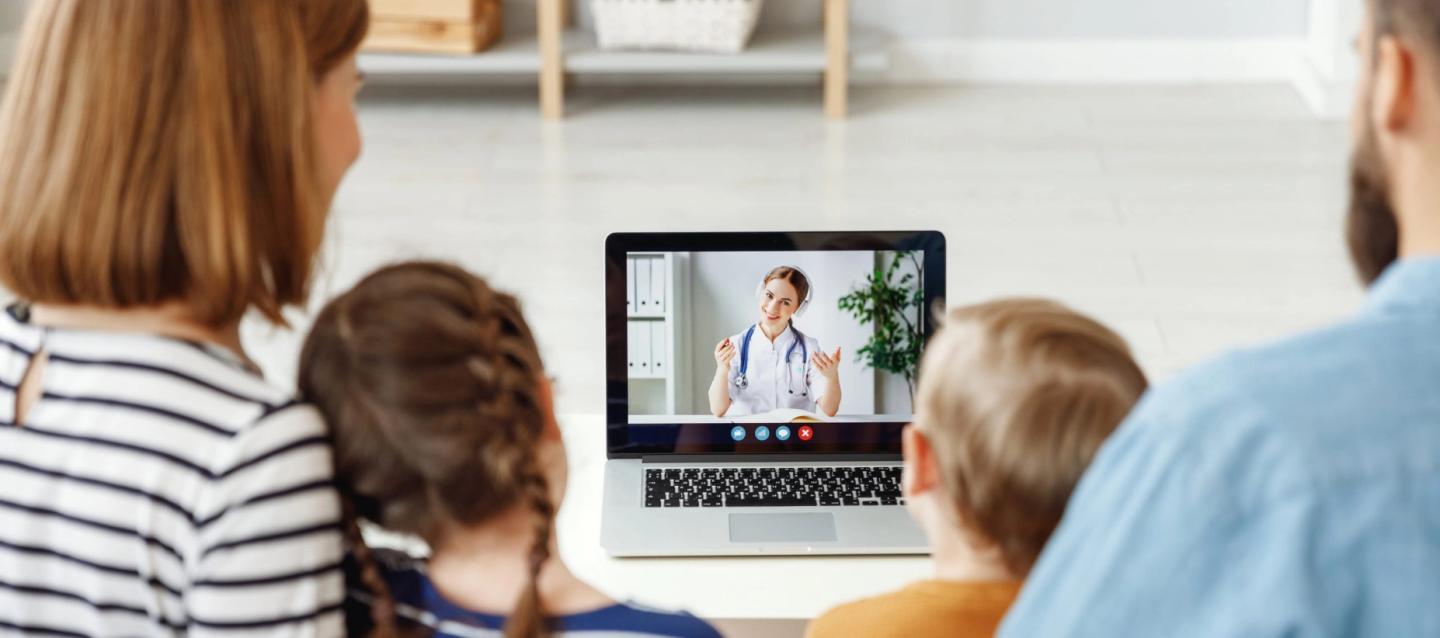Recent years show the rapid consumerization of healthcare. Its most evident signs are the development of patient-centric care and the change in healthcare consumer attitudes. For example, since 2020-2022, patients have become more engaged in medical services, according to the survey . Here are some numbers that prove it.
- Consumers prefer virtual visits more frequently than ever before. The visits increased from 15% to 19% between 2019 and the beginning of 2020; this figure spiked to 28% in April 2020.
- Clients increasingly embrace technology and applications to monitor and manage their health. In 2020, 42% of consumers reported using tools to monitor their exercise levels and health-improving objectives.
- 77% of patients who track their health claim it at least slightly alter their behavior.
- More people are eager to share their data and use technology to monitor their health: Customers order prescription medicine refills and track their fitness using technology.
Such numbers show that the medical industry is changing. Healthcare businesses should adapt to these shifts to stay competitive.
Wondering how to get along with the consumerization of healthcare and improve telemedicine software development services ? We're ready to share our expertise to help you out. Read our new material to understand the essentials of consumer healthcare and how to build telehealth software that fits its requirements.
What is consumerization of healthcare
In brief, consumerization of healthcare is a shift of the industry focus to the individual consumer rather than the market as a whole. Medical clients are no longer viewed as patients. Instead, they become consumers for businesses providing medical services. Hence, healthcare companies apply more client-specific virtual healthcare technology targeting and become more focused on marketing their telemedicine services. The fundamental aspects of patient-centric healthcare are patient engagement and disease prevention.
Let's start with patient engagement. There are many ways in which patients can participate in the healthcare process more actively. Here are the most valuable aspects of consumer health engagement:
- Willingness to disagree with a doctor
- Engagement in healthy behavior and disease prevention
- Active tracking of their health conditions
- Continuous update of their health data records and medical documentation
Consumer health aims to create a health-aware and proactive medical client. It has to be a person who views healthcare companies as ordinary service providers rather than organizations that offer on-demand emergency care.
Regarding disease prevention, consumerization enhances telehealth technologies that continuously monitor consumer health . The ultimate goal of consumer-driven virtual telehealth is to raise customer medical awareness. This means they continuously use virtual healthcare services instead of referring to them only in case of health issues.
Revamp and create user-oriented healthcare solutions
What major factors are responsible for fueling healthcare consumerization?
- Increased access
More healthcare services and information are available to patients now than ever before. There are various telemedicine choices available, as well as urgent care facilities and other new players in the healthcare market. Many give patients novel and flexible treatment options and transparent pricing.
Patients now have better access to additional treatment alternatives, scheduling flexibility, and even greater access to previously only available in-person services. Comparing the first quarter of 2020 to the same period in 2019, the number of telehealth visits grew by 50% . Consumers now have more access to acute, chronic, primary, and specialty care because of ongoing revisions to telehealth regulations and legal exemptions.
Patients are continually learning about new alternatives accessible to them, so if you cannot provide the treatment they are seeking — for example, a particular clinical trial they have heard about or a less invasive procedure — they will quickly find those who can.
- Impatient patients
Americans have become accustomed to "living on-demand," whether we're pre-ordering coffee at Starbucks or using Spotify to listen to anything we want whenever we want. Millennials and Gen Z have higher expectations for the digital world and are more engaged information consumers online; they now demand the same level of patient-centered convenience from healthcare.
78% of Gen Xers and 85% of Baby Boomers have a primary care physician compare to 66% of Millennials. They wearable technology three times as frequently and telemedicine twice as frequently as Baby Boomers. Due to the generational change, the demand for healthcare to become more consumerized will eventually increase. Healthcare firms will go out of business as generations become older if they don't adapt.
- Consumer empowerment
In retail, CPG, and technology sectors, well-informed consumers with high expectations receive what they need. Best-in-class businesses in these other industries prioritize the needs of their customers by offering the most pleasurable experiences to entice repeat business.
Furthermore, it is reasonable to assume that knowledgeable and empowered patients would also be informed, consumers. Four out of five of your patients will look up their diagnoses online and compare the results to the data you're providing. Connecting the linkages between their electronic health records, claims data, test results, and other information allows patients to understand better their overall health and a greater sense of control over its course.
- Risings costs of care
The consumerization of healthcare is mostly driven by cost, which is the last but most important factor. The cost of care has steadily increased, causing consumers of the healthcare sector to consider what they are paying for and look for methods to reduce the cost of care for their families. In 2023 , the US healthcare cost is projected to grow by 6.5%.
Due to growing consumer demands, patients now see greater pricing transparency from healthcare providers than ever before. They may now compare prices across the different service providers and receive estimations for surgeries and other procedures. It should not be surprising that when expenses grow, so do client expectations.
- Doctors see the benefits
Doctors attend medical school to care for people. Still, somewhere along the line, they frequently become bogged down by paperwork, scheduling, invoicing, and other administrative duties that take their attention away from treating patients.
Both patients and medical professionals will continue to benefit from improved workflow through consumerized digital health. In a study of more than 1,500 AMA physicians and other healthcare workers, 72–83% (varying by region) agreed that telemedicine increased the timeliness of care. Additionally, 45-53% claimed it strengthened their practice's financial situation. Most crucially, 45-56% of respondents said that participating in digital healthcare practices has increased their job satisfaction.
- Tech companies are now health companies
More than 1,000 technology entrepreneurs have recently joined the healthcare industry, many of them with a focus on digitizing the patient journey. There are companies in home healthcare, direct-to-consumer lab testing, wearable diagnostic and monitoring devices, and digital health record management, in addition to telemedicine consultations and asynchronous chat. In 2021, an estimated $30 billion will be invested in digital healthcare, a four-fold increase from only two years ago. By the way, we recently wrote an article about digital biomarkers in healthcare , perhaps this will also be of interest to you.
In 2020, 43% of respondents said they owned a wearable, up from 33% in 2019 based on Rock Health's 2020 Digital Health Consumer Adoption Report . The same survey indicated that 66% of customers who began using a wearable for the first time during the pandemic do so to manage a diagnosed health problem, demonstrating that consumers are now adopting wearables for purposes other than just maintaining their general health.
AWS-based Primary Care Platform
Binariks helped scale a web platform for patient monitoring and management
5 tips for implementing consumer telemedicine advantages
Consumerization of virtual healthcare technologies creates new demands for medical businesses. Here are some relevant suggestions on consumer health technologies that help you ensure patient-centric care.
- Establish IoT systems
Implement one of the main telemedicine advantages, namely the possibility to provide healthcare services remotely. Remote patient monitoring updates doctors about any changes in the patient's condition. The patient should record their health parameters with IoT devices and send such measures to the doctor. With remote health systems , patients are more likely to receive help on time since there is no need to wait for in-person doctor appointments. Due to such benefits and convenient user experience, IoT technologies are rapidly embracing the consumer health industry. Studies show that third to half of medical customers are comfortable using at-home diagnostics for various reasons.
- Provide the patients with access to health data
Since 5 April 2021, healthcare businesses must comply with the ONC Information Blocking provision. It requires health IT developers and medical service companies to provide patients with the covered USCDI data upon request. Here is the list of such data types.
Follow the FHIR data exchange standard to meet this provision. The standard allows healthcare consumers to access the required data smoothly and securely . FHIR also defines a specific format in which patients receive health data records, which ensures data consistency in virtual healthcare technology.
- Build virtual telehealth communication channels
Establish telehealth communication channels to help your clients stay in touch with doctors. Integrating these communication channels into your consumer health software is the best solution. The most popular option is introducing a message center. Apart from chatting, healthcare consumers and practitioners can use it for sharing files and relevant images.
Some virtual telehealth businesses apply in-app video chats. Sometimes, video meetings can replace traditional in-person meetings between a doctor and a patient. However, such a solution requires high software productivity. Most healthcare companies use third-party video conference platforms like Skype, Google Meet, and Zoom. Implement an in-app video conference feature only if you cannot rely on third-party tools because of security concerns.
- Ensure interoperability of virtual healthcare
Make all virtual telemedicine apps work as the elements of a single system. This will ensure more efficient interaction between patient apps and practitioner software, such as healthcare management platforms and EHR reimbursement for telemedicine and databases. Therefore, the interoperability of telehealth technologies facilitates the consumerization of healthcare by enforcing patient engagement.
To build healthcare interoperability, use common data formats for all applications within your system. It is one more case when FHIR may help . Adhering to this standard ensures efficient and safe data exchange between various virtual telemedicine apps. In addition, FHIR allows you to achieve essential for the consumer health industry regulatory compliance .
- Launch virtual nursing assistants
Implement virtual nursing assistants to add informative value to your products. This will help you respond to some basic needs of health service consumers. Virtual nursing assistants are rule-based or AI-driven analytics and information systems designed to improve the quality of patient-centric care.
In most cases, those are bots capable of conducting patient wellness checks and communicating with consumers of virtual telehealth services. The use of such technologies facilitates disease prevention. They provide a personalized experience to medical customers and minimize the need for in-person medical appointments.
Want to become HIPAA-compliant?
Learn about best practices of FHIR implementation.

The best solutions for healthcare consumerization
Virtual consultations
Telemedicine is a successful method of providing some medical treatments because it fills in the gaps in healthcare delivery in remote locations and conforms to millennials' online-first preferences. It frequently replaces in-person visits, may treat a minor illness, and facilitates provider collaboration.
Electronic consultations go hand in hand with video conferencing technology, while some clinics offer free hotlines for patients to call and give medical advice. Patients require more individualized treatment, easier access to physicians, time savings, and cost savings.
Remote monitoring
Remote patient monitoring is an additional choice for housebound patients who lead busy lifestyles or prefer high quality and practicality.
Managing chronic diseases and medications is made possible by various applications. For instance, a voice application may remind a diabetic patient to take insulin. Alternately, patients with hypertension or hypotension can utilize digital blood pressure cuffs to communicate their blood pressure and pulse to their PCP. Without leaving home, all of this.
We also suggest reading our other article on remote patient monitoring software development if you want to learn more about it.
Fast and easy scheduling
It's easy to schedule appointments with an automatic scheduling tool. It improves interactions between physicians and patients by enhancing accessibility, transparency, and simplicity compared to in-person meetings, phone conversations, or emails.
The disorganized scheduling system slows down the delivery of healthcare and raises administrative costs. To make it easier for back office personnel to manage timesheets, payrolls, and billings, the data should ideally be synchronized to the provider's practice management system.
Up-to-date and accurate patient data
Consumerization of healthcare encourages more providers to use online forms. IT solutions that are interoperable simplify information sharing. As a result, coordination among stakeholders is made simpler, and medical data accuracy is increased. Better patient experience with healthcare as a consequence.
For instance, EHR software may help you with reminders for checkups, health maintenance alerts, avoiding drug interactions, billing report generation, and more. You get in the direction of thorough data utilization, which benefits patients and influences the health data and therapeutic process through patient portals and remote monitoring applications.
Computerized physician order entry systems
Computerized Provider Order Entry (CPOE) is a system that offers tools to providers so they may electronically insert, prescribe, and record drug data rather than doing it manually.
First off, CPOE streamlines the process of entering and filling prescription orders. Also, there are fewer prescription errors. You will have an additional justification for using the solution if you combine this with a shorter stay and a quicker turnaround for lab testing.
Streamlined diagnostics
Some interactions, as long as they are hidden from patients, lead to greater therapeutic outcomes. Using the store and forward method, healthcare professionals may communicate effectively with one another and exchange medical information, reducing the risk of improper prescriptions and avoiding unnecessary testing.
With this strategy, communication is more flexible, and the decision-making process is given more latitude. Finally, telemedicine streamlines workflows and lessens data overload when connected with EHR systems, enabling it to provide patients with appropriate treatment.
Binariks can help you create solutions for great healthcare experience
Binariks is a healthcare software development company featuring many communication channels, self-service options, and strong security to improve the patient experience.
One of our clients is a digital healthcare firm that offers a diagnostic service solution that permits FDA-approved self-testing and real-time outbreak monitoring. The US and a few Asian markets can now use the solution.
The business has broadened its product line to include quick, individual home self-testing for persons and corporations. Corporate clients utilize the DaaS technology to reduce hospitalization, shutdowns, and absenteeism costs.
Our engineers assisted customers in meeting deadlines, growing their products, changing their monolithic architecture to one based on microservices, and becoming HIPAA compliant. We improved the previous solution's code and assisted the customer in changing the architecture from a monolithic to a microservice-based one.
Final thoughts
Now you know about the most valuable telehealth and technology features that help you build patient-centric healthcare. This brings you great chances to thrive in the consumer healthcare industry. The lack of technical expertise may become an insurmountable obstacle to your adaptation to the industry demands.
The best solution is to let experienced software engineering specialists handle the development of custom consumer health solutions. Binariks is ready to boost your product growth. We have significant expertise in custom telehealth and technology development. Check our portfolio to know about Binariks virtual healthcare technology projects.
Contact us to build consumer-driven patient-centric healthcare solutions together!
FAQ
Share

